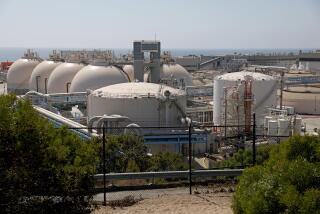State, Navy Settle Base’s Toxic Waste Violations
The U.S. Navy has agreed to improve its handling of toxic waste, pay $41,296 in state inspection fees and start a waste education program at the Seabee base in Port Hueneme as part of a settlement reached recently with the California Environmental Protection Agency.
In December, 1990, the state EPA found 27 violations of the state health and safety code at the Naval Construction Battalion Center, where toxic waste was being improperly handled, said Rich Varenchik, an agency spokesman.
The violations ranged from improper labeling and record-keeping to poorly sealed or leaking containers and the release of waste oil into the ground, he said.
“They began making really extensive improvements in the way they dealt with handling hazardous wastes out there” after the state EPA inspection, Varenchik said. “It’s been a real steady improvement.
“They’re not done yet,” Varenchik added, citing five “minor violations” of waste handling laws found in a state EPA inspection done at the base in January.
Since 1990, the Navy has strengthened its rules for handling hazardous waste on the base, said Cmdr. Lee Sollenberger, director of environmental affairs at the base.
“What we’ve done here overall is a number of different things to raise the awareness level of people who work here on base, of what is a hazardous waste and how do you handle it,” Sollenberger said Tuesday. “The way we’ve done that is . . . increasing our staffing.”
Sollenberger said the Navy has named someone in each department at the base to coordinate training military and civilian employees in proper methods of handling hazardous waste, so that employees “from the top down” know what’s right.
The Navy also is drafting an education program for handling household hazardous waste, such as motor oil and paint, as part of the settlement reached last week with the state EPA, he said. The program will involve showing base personnel and residents videotapes and giving them literature on the subject, Sollenberger said. “We don’t have it finalized yet.”
The Navy also agreed to pay $41,296 to the state EPA’s Department of Toxic Substances Control to reimburse the agency for the cost of inspections at the base. In addition, Navy officials agreed to set up emergency procedures and equipment for handling hazardous spills and to improve their inventory procedures for hazardous substances.
Although the violations at the base carry civil penalties of more than $400,000, federal law gives the Navy immunity from such fines, according to the settlement papers.
However, the settlement does not cover a host of toxic waste dumping that took place decades before the 1990 inspection, Varenchik said.
The Navy is already spending $5.5 million to evaluate ground and water pollution at several sites on the Port Hueneme base, where substances ranging from mercury and cancer-causing PCBs to pesticides and hydraulic fluid were dumped or improperly stored.
The U.S. Environmental Protection Agency and the Navy are working on cleanup plans for those sites and others at Navy bases around the country.
More to Read
Sign up for Essential California
The most important California stories and recommendations in your inbox every morning.
You may occasionally receive promotional content from the Los Angeles Times.










